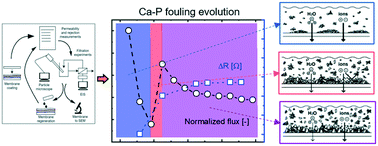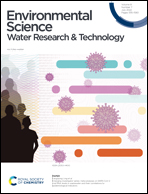Elucidating morphological effects in membrane mineral fouling using real-time particle imaging and impedance spectroscopy†
Abstract
Mineral fouling is a major hindrance to high recovery effluent nanofiltration, with calcium phosphate (Ca-P) and calcium carbonate (CaCO3) the most prevalent mineral foulants. In this study, we used a novel combination of real-time in-line microscopy, electrical impedance spectroscopy (EIS), post SEM analysis, and filtration metrics (water flux and rejection) to study mineral fouling mechanisms of Ca-P and CaCO3 salts in synthetic effluent nanofiltration. We used nanofiltration (NF) polyelectrolyte multilayer (PEM) membranes, prepared by static layer-by-layer (LbL) coating of a cationic polymer – polydiallyl dimethylammonium chloride, and anionic polymer – poly styrenesulfonate (six bi-layer) on a polyethersulfone (PES) ultrafiltration (UF) membrane. Increasing permeate recovery over filtration time was simulated by adding CaCl2 with NaHCO3 or NaH2PO4/Na2HPO4. Using the novel combination of methods, we delineated the mechanisms governing fouling development with time for both CaCO3 and Ca-P. For CaCO3, a transition from heterogeneous precipitation on the membrane surface (scaling) to particulate fouling due to bulk precipitation was identified. For Ca-P, a transition from fouling by amorphous particles to fouling by crystalline particles was identified; and this phase-change was captured in real-time images using an in-line microscope. We also found that for similar precipitation potentials measured by weight, Ca-P fouling was more detrimental to water flux (86% decrease) compared to CaCO3 (20% decrease) due to the voluminous amorphous phase. We established in-line microscopy as a new useful method to study mineral fouling, as it gives invaluable information on the suspended particles in real-time. Combining it with EIS gives complementary information on mineral accumulation on the membrane surface. Insight from this study and further use of these methods can guide future strategies towards higher effluent recovery by membrane filtration.

- This article is part of the themed collection: Emerging Investigator Series


 Please wait while we load your content...
Please wait while we load your content...